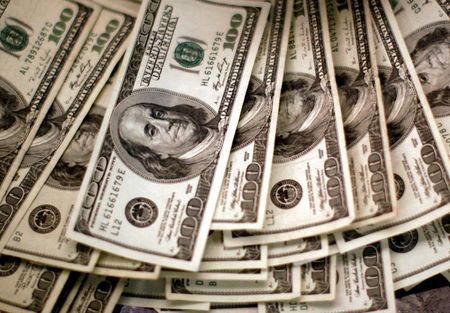By Davide Barbuscia
NEW YORK (Reuters) – A measure of the cost of borrowing short-term funds backed by U.S. Treasuries spiked this week to its highest since 2019, a move some market participants attributed to dealers closing their balance sheets for the year.
The DTCC GCF Treasury Repo Index, which tracks the average daily interest rate paid for the most-traded General Collateral Finance (GFC) Repo contracts for U.S. Treasuries, jumped to 5.452% on Tuesday from 5.395% last week. That is the highest level since September 2019, when dwindling bank reserves sent the cost of overnight loans as high as 10%, forcing the Federal Reserve to intervene.
The spike resulted from dealers closing their books for the year, which meant borrowers had to pay more to fund their collateral, several market participants said.
“It looks like there was a need for cash which drove up the overnight fund rates,” said Tom di Galoma, managing director and co-head of global rates trading at BTIG. “There is a lot volatility in overnight rates due to year-end.”
A spike in the price for repurchase agreements, or repos, in which investors borrow against Treasury and other collateral, can be a sign that cash is getting scarce in a key funding market for Wall Street. A three-day jump in the Treasury GCF Repo Index from Nov. 30 to Dec. 4 raised concerns on whether cash levels were sufficiently healthy.
This week’s GFC repo price increase is not worrying, said Steven Zeng, U.S. rates strategist at Deutsche Bank. “The GCF market is dealer to dealer lending, so a much more limited amount of cash (is) being moved around, resulting in higher rates.”
Because large dealer banks are offering less intermediation at year-end, cash in money market funds could not make its way to hedge funds and other cash borrowers. Increased usage of the Fed’s reverse repo facility, through which money market funds lend to the Fed, was evidence of money market funds wanting to invest cash but lacking private counterparties, Zeng said.
Cash flowing into the Fed’s reverse repo (RRP) facility jumped to $793.9 billion on Dec. 26 from $772.3 billion as of the end of last week.
“It’s year-end coming and bank balance sheets and window-dressing are preventing the money market funds from taking cash to banks,” said Scott Skyrm, executive vice president of Curvature Securities. “If it wasn’t year end … a lot more of that RRP cash would be flowing into the repo market.”
(Reporting by Davide Barbuscia; Editing by Ira Iosebashvili and Richard Chang)
